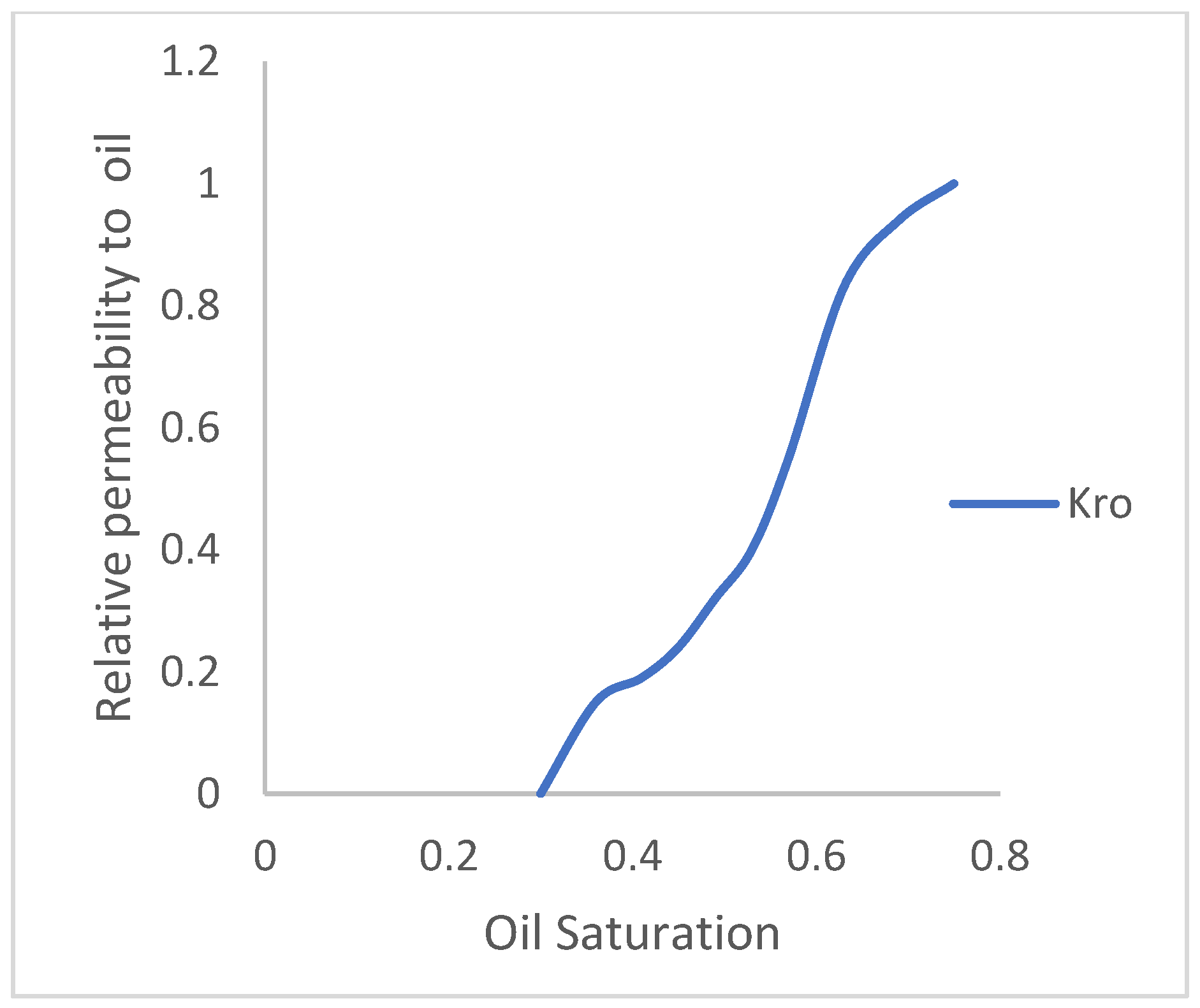An essential property for optimized oil production is its API gravity or fluid density. Reservoirs producing medium to heavy crude oil or those with an API gravity range of between 22.3 and 31.1° for medium crude oil and 10 and 22.3° [
1] for heavy crude pose serious production challenges. Naturally, heavy crude oil will not flow because of its viscous nature, and to optimize production, secondary or enhanced recovery processes need to be implemented [
2]. The option for water flooding is a natural selection for the optimization of oil production. However, the strategy is ineffective as the density of the injected water is lower than the residual heavy oil. This often leads to an irregular flood pattern that is enhanced by rock matrixes, well patterns, reservoir heterogeneities, and anisotropy [
3]. Options for enhanced oil recovery are mostly screened and ranked based on criteria relating to reservoir fluids and rock properties, costs, and reserves [
4]. Field implementations for thermal-enhanced oil recovery are challenging because of cost, loss of heat, the effect of heat signatures on the environment, coke formation, and loss of the lighter components of the hydrocarbon (for in situ combustion processes), and the scaling and fouling of facilities [
5]. A polymer-enhanced oil recovery is a suitable option for reservoirs producing heavy oil; when added to the injection water, they reduce its mobility and increase its viscosity, enabling a uniform and favorable oil displacement. To minimize costs, certain biopolymers can be sourced from waste materials like solanum tuberosum and banana peels [
6] to be utilized as an EOR option for heavy oil reservoirs.
Xanthan gum (XG) is an anionic biopolymer with repeated chains of cellulose monosaccharides and oligosaccharides. One of the key characteristics of xanthan gum is its high viscosity combined with a very high pseudo-plasticity, which means that its apparent viscosity decreases with an increase in applied shear force. In addition, XG is stable over a wide range of temperatures and pH; as well, it is water soluble but insoluble in a wide range of organic solvents. The rheology of aqueous solutions of XG has been studied over a wide range of shear rates and concentrations. At sufficient dilution and low shear rates, xanthan solutions show a region of Newtonian viscosity behavior [
7]. Gum arabic, a polyelectrolyte, is an emulsifier with binding, stabilizing, and shelf-life-enhancing properties. Gum arabic (GA) is a low-viscosifying enhancement agent and has a low molecular weight, unlike other biopolymers, and has an oil–brine IFT reduction capacity [
8,
9]. Its capacity to reduce oil–brine IFT is related to the polymer’s ability to migrate to the oil–water interface, in which the hydrophobic polypeptide chain interacts with oil and the hydrophilic arabinogalactan unit interacts with water [
10]. It should be noted that its surface activity properties are weak compared to most other surfactants. References [
9,
11,
12], in their studies, have summarized factors that affect the performance of polymers during enhanced oil-recovery processes. These factors include reservoir temperature, molecular weight, the composition of the polymer, the salt concentration of the polymer, and reservoir fluid. Other factors might include the injection rates, number of wells, and reservoir heterogeneity, which affects the adsorption rates of polymers on rock surfaces. Salts like sodium chloride (N
aCl), when present at concentrations as low as 2% wt., can result in a 23.8% loss in viscosity, while a similar concentration of divalent ions (Ca
2+) resulted in an approximately 28.6% loss of viscosity [
13]. The presence of salt causes an electrostatic repulsion of polymer chains, which leads to its contraction and the eventual loss of viscosity [
14]. Simulation studies on low-salinity-water flooding have been considered by [
15] to reduce the reservoir saline contents for light oil reservoirs with additional recoveries of 11% over water flooding, but the challenge with this option is low performance in medium to heavy oil reservoirs [
16]. References [
17,
18,
19] have experimentally investigated the oil recovery performances of polymer flooding options with a preconditioned reservoir with low salinity. Most studies on EOR (enhanced oil recovery) have been conducted via experimental studies. This involves obtaining representative samples of core samples from reservoirs (which must be preserved) and crude oil samples and the availability of permeability testers for core flooding processes. This can be time consuming and coupled with errors that can occur during the measurements. Hence, a simulation study can be conducted using software to carry out the experimental operation. A reservoir model can be built and incorporated with experimental data (such as polymer viscosities, shear rates, salt concentrations, etc.) using designated keywords. The software also offers similar examples and workflow guides/instructions to carry out polymer flooding. A simulation study will also allow for multiple-sensitivity analysis to be carried out effectively, as compared to core flooding experiments where core samples must be recycled/desaturated to subject them to new experimentation processes. The desaturation processes are not always efficient; thus, residues of previous experiments can alter the results of the next set of experiments if used. Another challenge with the experimental option (especially pore/core options), aside from the cost and duration, is the approach in carrying out multiple sensitivities to properly investigate the effect of salt on oil recoveries during polymer flooding. Furthermore, a preconditioned saline medium creates a static condition that makes the estimation of oil recoveries during saline changes problematic. This study first considers the effect of six different concentrations of xanthan and gum arabic polymers on oil recovery from a heavy oil reservoir created using the Eclipse black oil model. In doing so, models based on specified concentrations are developed with similar rock and fluid properties, fluid contacts, and well designs. Each of these models is subsequently subjected to two concentrations of the saline reservoir conditions. It is important to note that this is not a low-salinity flooding procedure but a natural saline condition of the reservoir fluids/injected polymers.



















































